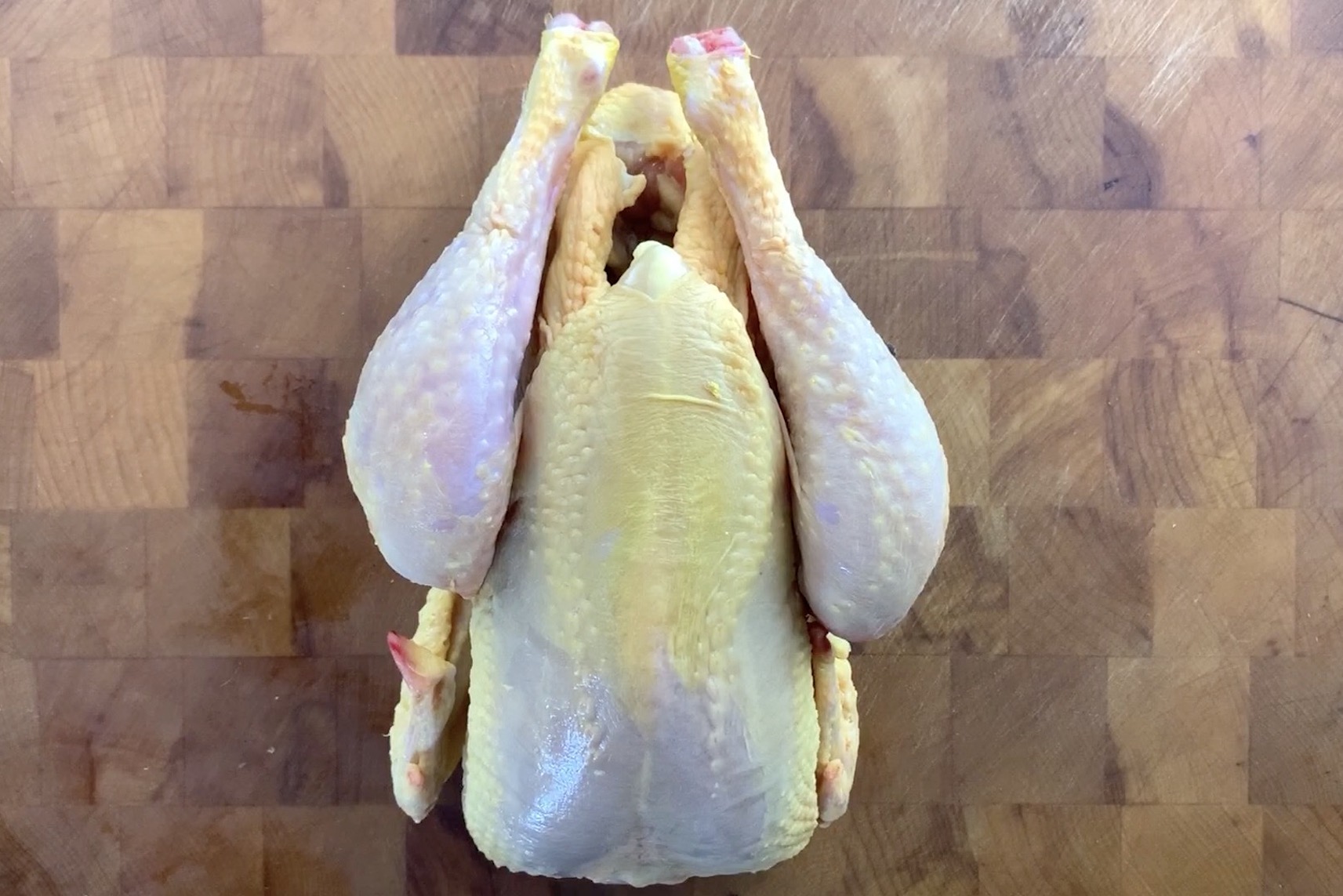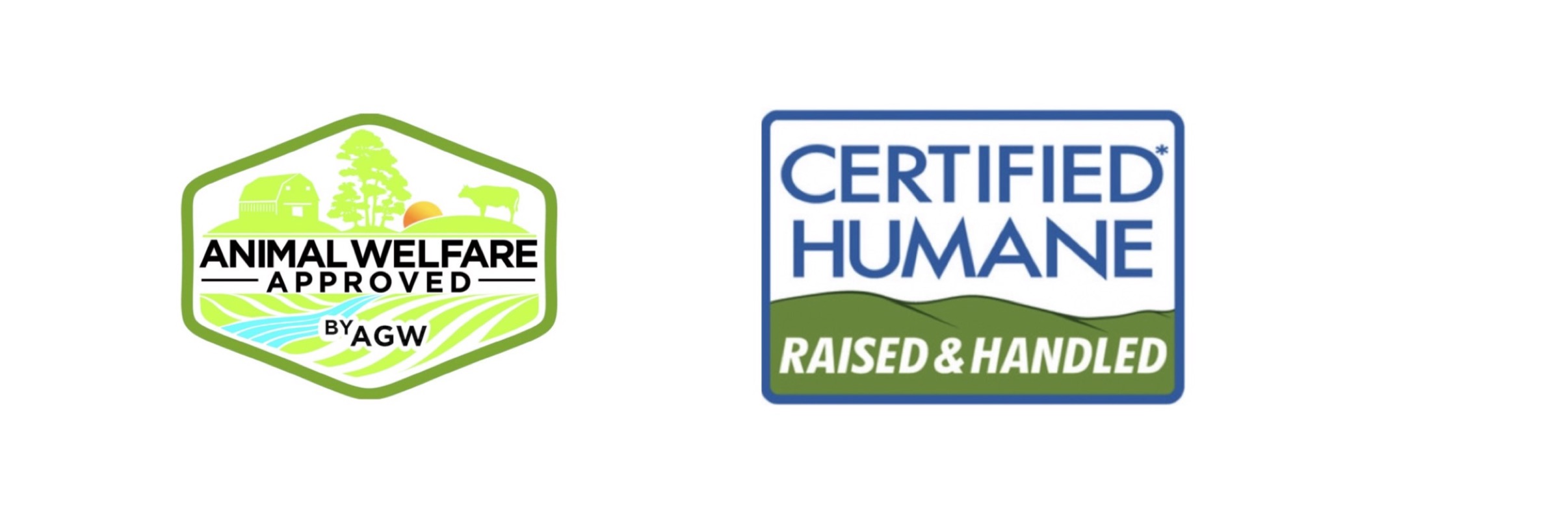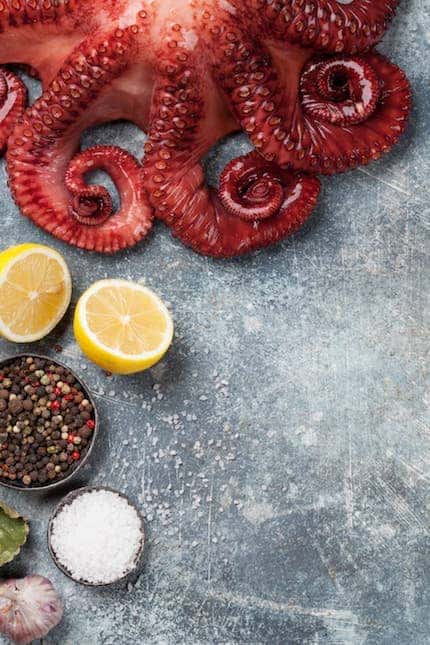What You See Is What You Get
A field guide to chicken labels.
From clams to carrots, ingredients reveal their qualities in the way they appear. Labels can only affirm your own impressions.
Look at this chicken, for example:

Right away, you see two muscular legs looming over a slender breast. The bird was “free range” in the proper sense of the term.
The meat of a chicken like that will always be rather sinewy. Its legs will have a raw, sanguin appearance that remains even after cooking. Its flavor will be nuanced and well-rounded, and its bones will result in a broth that tastes especially rich.
A free-range chicken, in other words, is self-evident.
Notice the yellow skin of the bird, which indicates a diet mostly of corn, which makes the meat richer. Many people find also that a corn-fed chicken tastes sweeter and has a more pronounced “chicken” flavor, overall.
Those are matters of preference, not quality. Top-tier chickens exist that have been fed ordinary grains like wheat, sorghum and barley precisely for people who find the flavor of those birds to be more subtle and nuanced.
The bird appears dry to the touch. It isn’t water-logged. It was air-chilled, in other words. You can see finally that it doesn’t have any lacerations or weird stains. (It’s completely odorless, as well.)
You don’t need a label to tell you that this bird was produced by people who probably knew what they were doing. You don’t have to stage an interrogation in front of the meat counter in order to ascertain the chicken’s provenance. You can just take it home and taste it yourself.
Because that is the final test. If the product performs as it should, roasting or sautéing nicely without leaving a puddle of water in the pan, if it’s delicious and has a nice texture, then you know you’ve found a brand you can trust.
As for the label on the package—well, that’s another matter.
Deciphering any statement at a supermarket requires you to appreciate the difference between a certification and a claim.
The latter is defined by none other than the claimant, who determines the extent of his or her own compliance. No independent verification exists, no guarantee is offered.
The tolerance for dubious claims within our legal framework goes some way in explaining the colorful variety of labels we have regarding, for example, antibiotics, where you’ll find a cornucopia of marketing phraseology that includes raised without antibiotics (the only seal that carries even the plausibility of certification), never given antibiotics (as though it were some kind of treat), no antibiotics ever (hysterically emphatic), no medically important antibiotics (as if there were such a thing), and no growth-promoting antibiotics (antibiotics are not growth hormones, which chickens are prohibited from receiving, anyway).
Equally enigmatic is the word “humane.”
Neither the FDA nor the Department of Agriculture have furnished us with a legally binding definition (although the former publishes guidelines to that effect).
Stepping in to fill the void are three non-profit organizations, which claim to carry out inspections. They disagree on basic standards, however, which no federal agency verifies, anyway. All three organizations accept fees from poultry producers, moreover, in exchange for the right to bear their seals, leaving producers free, I imagine, to select the set of standards with which they most easily comply, whether that involves outdoor access, antibiotics, or the administration of “physical alterations.”
And that still leaves us circling around the most important question of all, still unanswered, which is:
What really matters?
Which labels address the chicken’s suitability as an ingredient? Which keywords refer to qualities that actually impact your health? (I take it for granted that we all want the chickens to live peaceable lives.)
What follows answers those questions. You’ll discover the terms that really matter along with the ones to ignore as redundant or disingenuous.
- Chicken Labels: A Field Guide
- AIR-CHILLED—significant
More so than any other label, this one implies the greatest impact on the performance of the chicken as an ingredient.
“Air-chilled” refers to the method that the poultry producer used to cool the chicken carcass immediately after slaughter. Prompt chilling is required by law as a way to inhibit pathogens like Salmonella. The least expensive way to do that is by immersing the chicken in a chilled bath of chlorinated water.
That causes the meat to absorb some of the bath water, however, which dilutes the chicken’s flavor. The excess water also has a tendency to escape as the chicken cooks, producing steam that prevents the bird from browning nicely as it roasts or sautés.
As if that wasn’t enough, the extra water inflates the price of the bird, which is after all based on weight. Producers sometimes put a retained water statement on the package, presumably as a gesture of consumer welfare so that you can do the arithmetic yourself as you stand in the middle of the supermarket aisle, factoring the price of the bird against the percentage of its net weight that actually constitutes chlorinated water.
Save yourself the trouble. Buy a bird either with the label air-chilled or one that doesn’t appear to be embalmed in a plastic water balloon.
- FRESH—significant
This states that the meat was never frozen.
Ice crystals have sharp edges that can shred meat fibers, the result of which is a mushy texture and juices exuding all over your cutting board rather than inside of your mouth.
Modern flash-freezing methods, on the other hand, chill foods so quickly that the crystals remain too small to cause any harm. The process is so fast that foods don’t even have time to adhere to one another: Flash-frozen peas roll around one another like tiny pebbles, chicken breasts look and feel just like bagfuls of roofing shingles—simply extraordinary, this technology—a whole chicken… well, a flash-frozen chicken doesn’t look any different from a conventionally frozen one. Either way, the bird could have thawed at any point during transit.
So, fresh indicates one less thing you have to worry about.
- CAGE FREE—redundant
Only egg-laying hens are made to live in battery cages. Factory-farmed chickens otherwise enjoy lives of minimum-security imprisonment, in giant sheds where twenty-thousand birds mingle beneath omnipresent fluorescent lighting.
- FREE RANGE—disingenuous
This label states that the inmates had access to an exercise yard. Chickens don’t necessarily avail themselves of the privilege, however. They tend to congregate near sources of food and water, which are typically indoors.
Nothing stipulates the size of the yard, at any rate (nor crucially, perhaps, the size of the door leading to the yard). Nor does the Agriculture Department, which defines free range, conduct inspections to enforce compliance.
Fortunately, you can determine for yourself whether a chicken was raised in the proper sense of the term “free range” just by comparing it to that photo above. There, you can see what a bird really looks like that lived an honestly free-ranging life.
The effects are quite evident. Free range is not a concept that rests on philosophical axioms. We aren’t counting angels on the head of a pin, here.
Free range does require us to have an honest reckoning with ourselves regarding the true price tag of good animal husbandry.
What I mean is that a truly free-range chicken weighing only three-pounds will cost you about fifteen bucks (triple the usual price). To find one, you’ll have to locate a place with the kind of clientele who demand that sort of thing. Such a vendor may exist in your area only at a weekly market of some kind. (They’re online, as well.)
As more people recognize and demand the qualities of excellent meat, it stands to reason that the product will become more widely available. In France, for example, where demand for superior ingredients is taken for granted, high-caliber chickens can be found in mass-market grocery stores across the country.
Still, the cost of that quality comes out of the customer’s wallet. That’s one other thing the French take for granted.
Truly free-range chicken reminds us that high-quality meat remains a delicacy, if not an outright luxury. No shame exists in serving your family Chef Boyardee some nights if that’s what it takes to afford it. I do it myself.
- ANIMAL WELFARE APPROVED or CERTIFIED HUMANE—significant, potentially

These labels represent the spirit of the Geneva Convention for prisoners of war, applied to chickens. Each seal of approval promises that the producer made its facility available to independent monitors who verified that certain agreements were met regarding humanitarian treatment.
Animal Welfare Approved is the seal of A Greener World, a non-profit organization endorsed by a committee of animal welfare advocates and agricultural producers. Certified Humane is the seal of Farm Animal Care, who count among their advisors scientists, as well.
These organizations aim to define exactly what constitutes things like nutritious feed, clean water, adequate living conditions, safe transportation, and humane slaughtering, and to enforce those standards with annual inspections by knowledgeable professionals.
That’s the ideal, at any rate. As I mentioned above in my introduction, neither organization is itself inspected by an overarching agency, and each one accepts fees from producers for the right to bear its seal.
That isn’t to say that these organizations fail to accomplish what they’ve set out to do. In fact, both receive favorable ratings from Consumer Reports.
Indeed, if these agencies really are equal to their claims, then they deserve our support if for no other reason than they prohibit subtherapeutically administered antibiotics, which is a subject that I discuss in detail below.
(A third major organization exists that maintains weaker standards all around. It is American Humane Association, recognized by its seal American Human Certified.)
- HORMONE-FREE—redundant
The FDA already prohibits the use of growth hormones in poultry.
- FARM-RAISED—disingenuous
A “farm,” according to the Agriculture Department, is any place capable of yielding one thousand dollars in agricultural income—about half the annual revenue of one dairy cow, in other words.
- NATURAL—redundant
This states that the product before you is indeed a fresh chicken, not sausage meat. Neither has it been cured like a ham. The bird retains its “natural” state, in other words.
- VEGETARIAN or ALL-VEGETABLE DIET—disingenuous
A chicken is not a vegetarian, which is to say an herbivore.
The bird is an omnivore, one that’s capable of eating a fair number of insects and worms, even a small reptile now and then.
Commercially raised chickens don’t really have access to that kind of thing, as you might expect. Their diets must include protein supplementation. Terms like vegetarian and all-vegetable diet indicate that the additional nutrition was supplied by plants, namely soy.
Health officials prefer soy to the pulverized hooves, feathers, and dried blood that traditionally supplement chicken feed, ingredients that have been blamed for spreading diseases like mad cow. The practice of feeding livestock the rendered parts of other livestock is now widely condemned, in fact.
Soy protein poses its own nutritional problems, however. It lacks several vitamins and minerals necessary for a chicken’s health and longevity. Additional supplements must be added in order to prevent bone dystrophy and premature death.
It’s fair to ask, I suppose, whether a multi-vitamin can truly replace a worm or a maggot—whether zinc and Vitamin E supplements, to name two, prevent health abnormalities of only a conspicuous kind.
It might be the case, then, that the pulverized fish carcasses, insect larvae and dairy scum that some producers feed to their chickens yield a securer state of well-being for those birds (and by extension the people who eat them).
Of course, we wouldn’t be able to call those chickens “vegetarian.”
- KOSHER—significant
This label has nothing to do with the casual sense of the word “kosher” (meaning legitimate). It refers to a dietary framework, derived from the books of Leviticus and Deuteronomy, that strictly defines foods suitable for Jewish people, including the famous injunction against pork.
Kosher law stipulates among other things that a chicken be slaughtered with a quick slit to the neck using a very sharp blade, in order to ensure immediate unconsciousness. Organs must be examined afterwards for various imperfections meant to indicate poor health. Afterwards, the bird must be salted in order to draw out blood and other elements deemed to be impure.
That last rule is what potentially concerns the home cook. Salting a chicken improves not only its taste but its texture, since salt transforms meat fibers in a way that enables them to more easily retain their flavorful juices.
Salting doesn’t have to occur long in advance. You can do it right before you cook, as high heat compels salt to rapidly disperse. A kosher chicken just saves you the trouble.
Kosher has little to say otherwise regarding contemporary concerns like open pasture and organic feed.
- NO ANTIBIOTICS—significant, potentially
Labels regarding antibiotics are unusual in that they have practically nothing to do with the performance of the ingredient in your kitchen nor its taste in your mouth.
They refer to the impact that poultry-rearing has on the world apart from the sphere of cooking and dining, which has unfortunately become a matter of widespread concern.
What’s at stake here isn’t a prescription now and then for a little sore throat, but the administration of antibiotics day-in and day-out (by adding them to the chickenfeed) in order to stave off infection of any kind.
Such a practice is called subtherapeutic administration, and it accounts for some eighty percent of the annual consumption of antibiotics in the United States, a situation that has given rise evidently to breeding grounds where pathogens that do manage to survive this pharmaceutical blitzkrieg emerge with a preternatural immunity to the medication in general.
Bacteria double themselves once every thirty minutes, after all. One bacterium can become one million over the course of a single day, a reproductive cycle that makes these organisms exceptionally adaptable.
That’s why doctors typically prescribe antibiotics in multiple doses while instructing their patients to take every last one, lest any bacterium capable of surviving merely a couple treatments re-multiplies into a new, drug-resistant strain.
The threat posed to public health by the misuse of antibiotics is not hypothetical.
A single outbreak of drug-resistant Salmonella that appeared in 2018 managed to hospitalize sixty people and kill two, according to the Centers for Disease Control and Prevention.
In its ordinary guise, Salmonella has been around for years. Bacteria of its kind are responsible for a classic line-up of symptoms that includes stomach cramps, vomiting, nausea, stiff muscles, and acute diarrhea—“food poisoning,” in other words, which we’ve come to regard as a nuisance but can be fatal if left unchecked.
Some fifteen percent of the U.S. population suffer ailments like these every year as a result of contaminated food, according to the Centers for Disease Control. Nearly 130,000 people wind up in the hospital because of them.
Once under medical supervision, if the problem turns out to be caused by a bacterial strain immune to antibiotics, then the doctor’s hands are tied. The patient remains at the mercy of fate.
Naturally, that scenario scares the hell out of people. Opinions divide on this issue, nevertheless. The reason for that is probably due to a peculiar quirk in the realm of science, whereby “proof” (the kind of thing that we expect to see in a court of law, for instance) is perpetually elusive.
In other words, no instance has ever come to light in which a specific strain of drug-resistant bacteria could be linked to a specific dose of antibiotics in a specific population of livestock.
Those who support the status quo can more easily narrow this concern to our rather mundane anxiety over food additives. They maintain correctly that chickens pass any medication through their systems before the time of slaughter, a fact verified by mandatory tests. The meat on your plate is always drug-free.
Meanwhile, the problem only worsens, as drug-resistant pathogens once linked mainly to food now turn up in all kinds of unlikely places.
Among these so-called superbugs is the notorious staphylococcus areaus, otherwise known as MRSA (mer-sa), which is capable of causing fatal infections throughout the body and now found to inhabit surfaces everywhere from gym mats to hospital gurneys. It’s so widespread, in fact, that many researchers have ceased altogether referring to it as a foodborne pathogen, per se, but a community-acquired one, meaning that you encounter it just by being out and about.
Certainly, you can go a long way toward protecting yourself from something like MRSA by practicing ordinary kitchen hygiene, such as washing your hands and sterilizing surfaces that contact raw meat. It’s all part of the basic workflow of a home cook, which I repeat frequently on this site.
You could take more drastic steps, of course. You could become a vegetarian. Alas, the meat industry would carry on, producing its notorious lagoons of liquid manure that spill onto vegetable crops from time to time, causing bacterial outbreaks on innocuous foods like lettuce and spinach.
You could, likewise, limit yourself to only those producers who claim to forswear antibiotics. But then, you’d have to rely on labels, where only the honor system prevails. Use of the phrase “raised without antibiotics” requires only a written claim to the FDA. No inspections, no guarantees.
Even if there was a completely transparent label—and the next one I review comes close—the threat of drug-resistant bacteria would persist as long as livestock handlers for the most part continue their heedless use of antibiotics.
For that reason, the ultimate solution is likely an all-out ban on subtherapeutic drug administration in livestock. The European Union has had one in place since 2006, for what it’s worth.
Here in the U.S., progress likely awaits a seismic shift in consumer inertia, a process that fortunately seems to be underway as sales and distribution of antibiotics for livestock have declined by about thirty percent over the last decade, according to the FDA.
Helping this trend no doubt is the price of meat from drug-free animals, which is no higher than the price of the conventional kind, according to Consumer Reports.
An even greater impact is had, I imagine, by one seal of approval that not only prohibits subtherapeutic antibiotics but is enforced by federal regulation and actually has enough clout to influence consumer demand.
That’s the next label that I address, and the final one on this list.
- ORGANIC—significant

This label encompasses all the others, to a greater or lesser degree. Use of the word “organic,” with or without the Agriculture Department’s official seal, is regulated by federal law and enforced by annual inspections.
To print that word on a chicken label, a producer must guarantee that the bird had access to the exercise yard (Free Range).
The chicken’s shelter must have been adequately ventilated, permitting free movement along with access to clean water and proper sanitation (Humane).
The chicken’s protein supplements must not have been derived from the byproducts of livestock slaughter (Vegetarian).
The chicken cannot not have received perpetual antibiotics (No Antibiotics).
And of course, whatever the chicken consumed must not have been grown using chemical fertilizers or pesticides. The same goes for the land on which it lived as well as the roughage on which it nested. Neither can the chicken have received genetically modified grain or synthetic preservatives.
Many people criticize the government’s criteria for organic as rather weak, particularly with regards to animal welfare. The USDA’s laissez-faire notion of “free-range” remains unchanged, for example.
However, the government’s criteria are backed by legally binding laws that are at least capable of being enforced. That reassurance may explain why sales of certifiably organic food in the U.S. have doubled since 2010. Over a third of all fruits and vegetables in the country now bear the Department of Agriculture’s seal. Sales of organically certified poultry have jumped in recent years and are expected to rise, according to the Organic Trade Association.
And yet producers abound, almost certainly, who follow the letter of the law while producing chickens of a quality that is something less than spectacular, the animals having led lives that were something less than healthy.
As I said in the beginning: Exercise your own judgement. What you see is what you get, regardless of any claim.
 |
SHARE THIS ARTICLE

No Comments